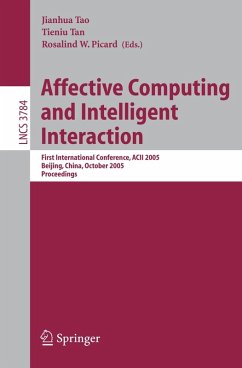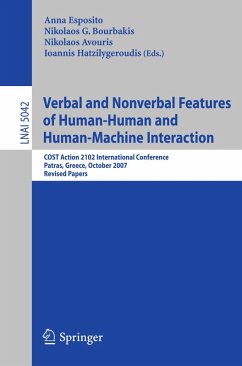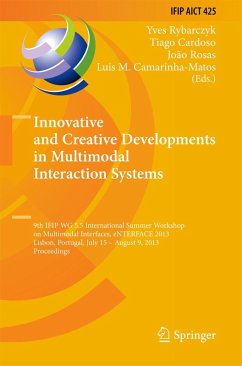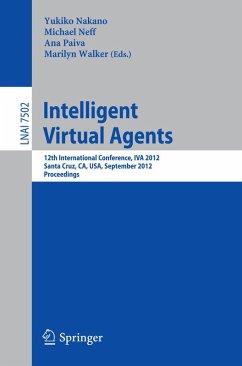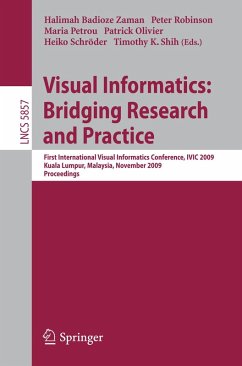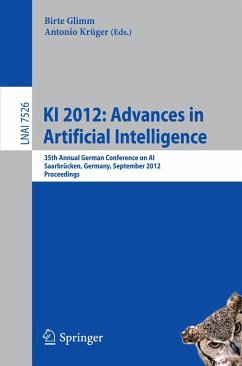
eBook, PDF
SmartKom: Foundations of Multimodal Dialogue Systems (eBook, PDF)

PAYBACK Punkte
36 °P sammeln!






With contributions by leading scientists in the field, this book gives the first comprehensive overview of the results of the seminal SmartKom project - one of the most advanced multimodal dialogue systems worldwide.
Dieser Download kann aus rechtlichen Gründen nur mit Rechnungsadresse in A, B, BG, CY, CZ, D, DK, EW, E, FIN, F, GR, HR, H, IRL, I, LT, L, LR, M, NL, PL, P, R, S, SLO, SK ausgeliefert werden.
Prof. Dr. Dr. h.c. mult. Wolfgang Wahlster is the Director and CEO of the German Research Center for Artificial Intelligence (DFKI GmbH) and a Professor of Computer Science at the Universität des Saarlandes, Saarbrücken. In 2000, he was coopted as a Professor of Computational Linguistics at the same university. In addition, he is the Head of the Intelligent User Interfaces Lab at DFKI. He was the Scientific Director of the Verbmobil consortium on spontaneous speech translation (1993-2000), the SmartKom consortium on multimodal dialog systems (1999-2003), and the SmartWeb consortium on mobile multimodal access to semantic web services (2004-2008). He has authored more than 150 technical papers and 6 books on language technology and intelligent user interfaces, and edited many books, among them the Springer titles "Verbmobil: Foundations of Speech-to-Speech Translation", "SmartKom: Foundations of Multimodal Dialogue Systems", and "SemProM: Foundations of Semantic Product Memories for the Internet of Things". His research includes multimodal and perceptive user interfaces, user modeling, embodied conversational agents, smart navigation systems, semantic web services, and resource-adaptive cognitive technologies. He was awarded the Deutscher Zukunftspreis (German Future Award) in 2001 and he received the Federal Cross of Merit, First Class, the Officer's Cross of the Order of Merit of the Federal Republic of Germany in 2006. He is the Chief Academic Advisor for Information and Communication Technologies (ICT) in the Research Union of the German Government, he is a member or chair of many key international scientific advisory and governance boards, including the National Institute of Informatics (NII) of Japan, the jury for the European ICT Prize of the European Commission, the SingaporeAgency for Science, Technology and Research, the SAP Next Business & Technology Advisory Board, the Center for Advanced Security Research in Darmstadt, the Intel Visual Computing Institute, the Fondazione Bruno Kessler, and the Future Internet Public-Private Partnership of the European Commission. He is a member of many academies, including the German Academy of Sciences and Literature, Mainz, the Royal Swedish Academy of Sciences, Stockholm, the German Academy of Natural Scientists Leopoldina, Acatech, the Council for Engineering Sciences of the Union of German Academies of Science and Humanities, and the Berlin-Brandenburg Academy of Sciences and Humanities. He has chaired and given invited talks at the key international conferences in computational linguistics and artificial intelligence, he is a board member of the key AI journals, and he is a Fellow of the Association for the Advancement of Artificial Intelligence (AAAI), the European Coordinating Committee for Artificial Intelligence (ECCAI), and the Gesellschaft für Informatik (GI).
Produktdetails
- Verlag: Springer Berlin Heidelberg
- Seitenzahl: 645
- Erscheinungstermin: 5. September 2006
- Englisch
- ISBN-13: 9783540366782
- Artikelnr.: 37368198
From the reviews: "The book is organized into six parts, each of which contains several chapters. ... This book should be useful for many types of readers. Those who want to get a sense of the state of the art of multimodal communication ... will find it invaluable. Students who have had a good grounding in artificial intelligence or natural language processing should read the book to get an overview of how the techniques from these fields can be integrated into a comprehensive system." (J. P. E. Hodgson, ACM Computing Reviews, Vol. 49 (4), April, 2008)
Für dieses Produkt wurde noch keine Bewertung abgegeben. Wir würden uns sehr freuen, wenn du die erste Bewertung schreibst!
Eine Bewertung schreiben
Eine Bewertung schreiben
Andere Kunden interessierten sich für


